Let me tell you, if you’re hunting for flooring that’s tough, stylish, and kind to your wallet, Gaia Flooring is where it’s at. I’ve walked on plenty of floors in my time, but Gaia’s blend of durability, eco-conscious design, and jaw-dropping aesthetics makes it a standout.
Whether you’re revamping your kitchen or outfitting a whole house, this flooring can handle your chaos while looking like a million bucks. Trust me, you’ll want to keep reading to see why Gaia’s my go-to and why it should be yours too.
My Journey With Gaia Flooring
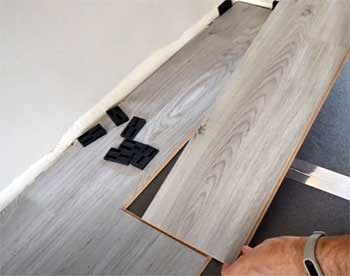
A couple of years ago, I was knee-deep in a home renovation, and picking the right flooring felt like a high-stakes game.
My house is a zoo—two kids, a hyperactive golden retriever, and a husband who’s not exactly delicate with his work boots.
I needed something that could take a beating, look good doing it, and not make me cry when I saw the bill.
After weeks of research, I landed on Gaia’s Stone Plastic Composite (SPC) flooring, specifically the Black Series Rhea.
The samples I ordered had this rich, warm oak texture that felt like real wood under my fingers, but the price tag didn’t give me heart palpitations.
The installation was a breeze, thanks to Gaia’s click-lock system. My brother-in-law, who’s handy but no pro, helped me lay it down in our living room and kitchen over a weekend. No glue, no mess, just satisfying clicks as the planks locked together.
The first thing I noticed post-installation was how quiet it was. Unlike our old laminate, which creaked like a haunted house, Gaia’s floors felt solid and muted underfoot. Even with my dog sprinting across them, there’s barely a sound.
Now, two years in, these floors have seen it all—spilled juice, muddy paws, and even a rogue marker incident. They still look as good as the day we installed them. The waterproof feature is a lifesaver; I don’t panic when a glass of water tips over.
Cleaning is as simple as a quick sweep and a damp mop. Honestly, it’s made my life easier, and every time someone compliments the wood-like finish, I grin and say, “It’s not even real wood!”
The Pros of Gaia Flooring
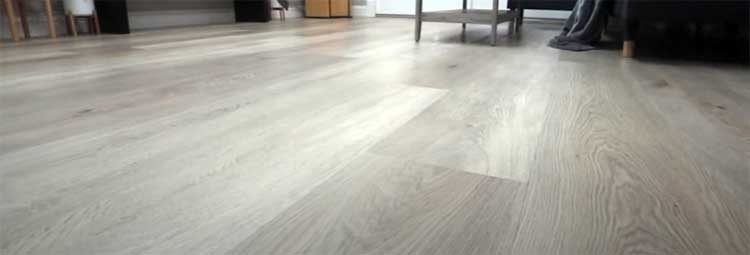
- Unbeatable Durability
You know those moments when your kid drops a toy truck from the top of the stairs, or your dog decides to drag a bone across the floor? Gaia SPC flooring laughs in the face of that chaos.
Its solid polymer core, made from limestone powder and PVC, is like the Hulk of flooring—resistant to dents, scratches, and wear. I’ve got high-traffic zones like my hallway and kitchen, and there’s not a single mark that screams, “We live here!”
It’s perfect for homes with pets or kids who treat your floors like a playground.
- 100% Waterproof Wonder
If you’ve ever had a floor warp because of a spill, you’ll appreciate this: Gaia’s SPC flooring is completely waterproof. I’ve installed it in my kitchen and bathroom, where spills are as common as sunrise.
A knocked-over water bowl or a splash from the sink? No problem—just wipe it up, and the floor’s fine. This makes it a game-changer for moisture-prone areas where hardwood would curl up and cry.
- Easy-Peasy Installation
I’m no DIY guru, but Gaia’s click-lock system made me feel like one. The planks snap together like puzzle pieces, no adhesives needed. You can cut them to size with a utility knife, which saved me from renting fancy tools.
Whether you’re a weekend warrior or hiring a pro, the installation is quick and painless. My 1,200-square-foot main floor took us two days, and that included coffee breaks and a few debates about plank patterns.
- Style for Days
Gaia’s got a design for every vibe, from rustic farmhouse to sleek modern. Their Black Series, like the Rhea I chose, has this hand-crafted texture that mimics real wood so well, my guests are shocked it’s not hardwood.
With colors ranging from warm oaks to cool grays, you’re bound to find something that matches your style. It’s like picking out a new outfit for your house—fun and totally customizable.
- Eco-Friendly Vibes
If you’re into saving the planet while upgrading your home, Gaia’s got your back. Some of their SPC lines use recycled materials, which makes me feel good about my choice. Plus, their manufacturing process aims to minimize waste.
It’s not just about looking good—it’s about doing good, too. Knowing my floors are a little kinder to the environment makes me love them even more.
The Not-So-Good Parts of Gaia Flooring
- A Bit Hard Underfoot
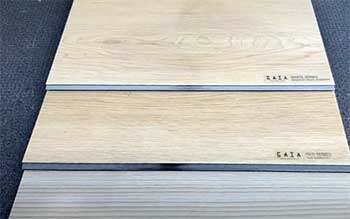
Let’s be real—Gaia’s SPC flooring is tough, but that rigidity comes at a cost.
It’s not as cushy as carpet or cork, so if you’re standing in the kitchen chopping veggies for hours, your feet might feel it.
I’ve gotten around this by tossing down a cushioned mat in high-stand areas, but it’s something to consider if comfort’s your top priority.
- UV Sensitivity
Here’s a heads-up: Gaia’s SPC flooring can fade if it’s basking in direct sunlight all day. I noticed a slight lightening in my sunroom where the sun blasts through big windows.
It’s not a dealbreaker, but you’ll want to invest in some UV-blocking curtains or blinds to keep those colors vibrant. It’s a small hassle for an otherwise stellar product.
- Not the Greenest Option
While Gaia uses some recycled materials, the PVC in their SPC flooring isn’t biodegradable. If you’re aiming for a fully eco-friendly home, this might give you pause.
That said, the durability means you won’t be replacing these floors anytime soon, which cuts down on waste in the long run. It’s a trade-off, but one I’m okay with given the other perks.
- Warranty Woes
I’ve heard some grumbles about Gaia’s warranty process, and I get it. A friend of mine had a tough time getting a claim honored for a crack in her floor. The company claimed it was an installation issue, not a defect, which felt like a cop-out.
My experience has been smooth, but it’s worth noting that their customer service can be hit-or-miss. Make sure your installer follows Gaia’s guidelines to avoid any headaches.
Maintenance Tips For Gaia Flooring
- Keep It Simple with Cleaning: You don’t need a PhD in housekeeping to keep Gaia floors looking sharp. A quick sweep with a soft-bristle broom or a dust mop handles everyday dirt. For deeper cleaning, I use a damp mop with a mild cleaner—no harsh chemicals needed. Stay away from abrasive scrubbers; they can dull the finish. I clean mine weekly, and it takes maybe 15 minutes for my whole main floor.
- Handle Spills Like a Pro: Since Gaia’s SPC is waterproof, spills are no biggie, but you still want to act fast. I’ve learned that letting juice or coffee sit too long can leave a sticky residue. Grab a soft cloth, dampen it with water, and wipe it up. For stubborn spots, a tiny bit of vinegar mixed with water works wonders. Just don’t let liquids pool for days—it’s waterproof, not invincible.
- Protect Against Scratches: While Gaia’s floors are scratch-resistant, they’re not scratch-proof. I put felt pads on all my furniture legs to prevent scuffs, especially under my dining chairs. If you’ve got pets with long nails, keep them trimmed—my dog’s nails were the culprit behind a few faint marks before I got on top of it. A little prevention goes a long way.
- Mind the Sunlight: To avoid that UV fading I mentioned, keep an eye on sunny spots. I’ve got blinds in my sunroom now, and they’ve saved my floors from looking washed out. If you’ve got big windows, consider UV-blocking film or curtains. It’s a small investment to keep your floors looking fresh for years.
- Regular Inspections: Every few months, I do a quick walk-through to check for any loose planks or weird noises. Squeaks can happen if the subfloor wasn’t perfectly level during installation. If you catch something early, it’s usually an easy fix. My brother-in-law popped a plank back into place for me once, and it was no big deal.
Comparing Gaia To Other Flooring Brands
Having lived with Gaia’s SPC flooring for two years, I’ve got a good sense of how it holds up. Let’s see how it compares to Paramount Flooring, NuCore Performance Flooring, and MSI Flooring, with each brand pitted directly against Gaia on key factors.
Gaia Vs. Paramount Flooring
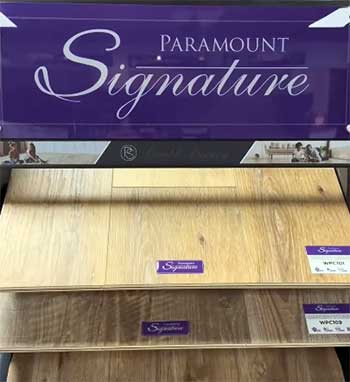
- Durability: Gaia’s 20 mil wear layer in the Black Series Rhea handles my chaotic household—kids, dog, and all—without a scratch. Paramount’s SPC often matches this with a 20 mil wear layer, but their premium lines hit 30 mil, which could be better for extreme wear. Still, Gaia’s been bulletproof for me.
- Waterproofing: Both Gaia and Paramount offer 100% waterproof SPC flooring. My Gaia floors laugh off kitchen spills, and Paramount’s tight click-lock system is just as reliable. No complaints here for either.
- Design: Gaia’s range, from rustic oaks to modern grays, feels endless. Paramount’s textures are rich, but their colors lean heavily into grays and browns, which might limit your vibe. Gaia’s Black Series Rhea looks so real, guests swear it’s hardwood.
- Installation: Gaia’s click-lock system is DIY heaven—my brother-in-law and I knocked out 1,200 square feet in a weekend. Paramount’s system is similar but heavier, which can slow you down if you’re not a pro. Gaia’s lighter planks win for ease.
- Price: Gaia’s Black Series costs $4–$5 per square foot, a great deal for the quality. Paramount starts similar but jumps to $6–$7 for thicker layers, which might stretch your budget. Gaia feels like better value to me.
- Eco-Friendliness: Gaia uses recycled materials, and Paramount does too, with a focus on sustainable manufacturing. Both are solid but not fully green due to PVC. It’s a tie here.
Gaia Vs. NuCore Performance Flooring
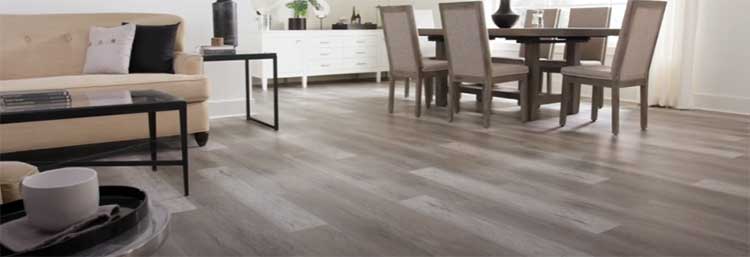
- Durability: Gaia’s 20 mil wear layer stands up to my dog’s antics and kid chaos. NuCore’s 22 mil layer is slightly thicker, but I’ve heard their planks can show wear in super busy homes. Gaia feels just as tough in my experience.
- Waterproofing: Gaia and NuCore are both 100% waterproof, perfect for my spill-prone kitchen. However, some NuCore users report loose clicks in humid areas, while Gaia’s stayed tight. Slight edge to Gaia.
- Design: Gaia’s realistic wood grains, like my Rhea, steal the show. NuCore’s designs are decent but less convincing, often looking a bit flat. If you want that premium wood vibe, Gaia’s ahead.
- Installation: Gaia’s click-lock is a breeze, even for amateurs like me. NuCore’s system is user-friendly but can feel less secure if not installed perfectly. Gaia’s forgiving nature makes it easier.
- Price: Gaia’s $4–$5 per square foot is a sweet spot. NuCore’s $2–$3 price tag is cheaper, but you lose some design flair and durability. For a forever home, Gaia’s worth the extra.
- Eco-Friendliness: Gaia’s recycled materials give it a slight green edge, while NuCore’s eco-credentials are less clear. Gaia feels like the greener pick, though neither is fully sustainable.
Gaia Vs. MSI Flooring
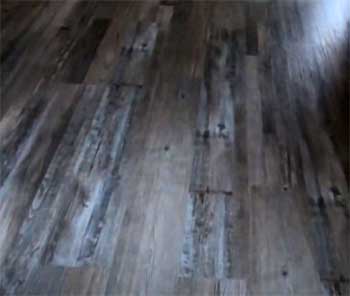
- Durability: Gaia’s 20 mil wear layer handles my hectic home with ease. MSI’s SPC ranges from 12 to 20 mil, so you need to pick carefully. Gaia’s consistency gives it an edge for reliability.
- Waterproofing: Both Gaia and MSI offer waterproof SPC flooring. My Gaia floors shrug off bathroom splashes, but some MSI users report minor gapping in humid climates. Gaia feels more dependable.
- Design: Gaia’s Black Series has a wood-like texture that fools everyone. MSI’s bold, trendy patterns are cool for modern spaces but less versatile than Gaia’s wide range of classic and contemporary looks.
- Installation: Gaia’s click-lock system is foolproof, even for DIY newbies. MSI’s is straightforward but needs a dead-level subfloor to avoid issues. Gaia’s more forgiving for uneven homes.
- Price: Gaia’s $4–$5 per square foot is reasonable. MSI’s prices swing from $3 to $6, depending on the line, making it hit-or-miss. Gaia’s predictable pricing feels safer.
- Eco-Friendliness: Gaia’s recycled materials and low-waste manufacturing give it a green boost. MSI makes some eco-claims but lacks transparency. Gaia’s the better choice for eco-conscious folks.
Frequently Asked Questions (FAQs)
COREtec and Gaia both make SPC flooring, but they’ve got some key differences. COREtec often uses a thicker wear layer (up to 30 mil vs. Gaia’s 20 mil in the Black Series), which can make it slightly more durable in heavy-traffic areas. However, Gaia’s IXPE cushioned backing gives it a quieter, warmer feel underfoot, which I find comfier. COREtec’s designs are solid but less varied than Gaia’s, and it’s pricier, often $1–$2 more per square foot. Gaia’s click-lock system also feels more DIY-friendly to me.
There’s no one-size-fits-all “best” brand—it depends on your needs. If durability and waterproofing are key, Gaia and COREtec are top contenders for SPC flooring. Shaw’s great for longevity but pricier. Pergo’s a budget pick but lacks Gaia’s premium feel. Flooret’s wear layer is impressive, but its designs are niche. For my home, Gaia’s balance of style, durability, and cost makes it a winner, but you should weigh your priorities—budget, aesthetic, or toughness.
Yes, Gaia’s SPC flooring is 100% waterproof. I’ve got it in my kitchen and bathroom, and it’s handled spills like a champ—think knocked-over water bowls and splashes from dishwashing. Just wipe them up, and you’re good. It’s perfect for moisture-prone areas where hardwood would buckle. That said, don’t let water sit for days; quick cleanup keeps it pristine.
SPC flooring, like Gaia’s, has a few drawbacks. It’s super durable but can feel hard underfoot, so it’s not as cozy as carpet for long standing. UV exposure can cause fading, so you’ll need curtains in sunny rooms. The PVC in SPC isn’t biodegradable, which might bug eco-conscious folks. Also, warranty claims can be tricky if the issue’s blamed on installation rather than a defect. Still, the pros often outweigh these for busy households.
Why Gaia Flooring Wins My Heart?
I can’t recommend Gaia Flooring enough if you want a floor that’s tough, gorgeous, and easy to live with. From surviving my family’s chaos to turningHeads with its wood-like charm, it’s been a game-changer in my home.
Sure, it’s got a few quirks, but the durability, style, and low maintenance make it worth every penny. If you’re ready to transform your space without breaking the bank, Gaia’s the way to go. You’ll thank me when your floors still look amazing years from now.
